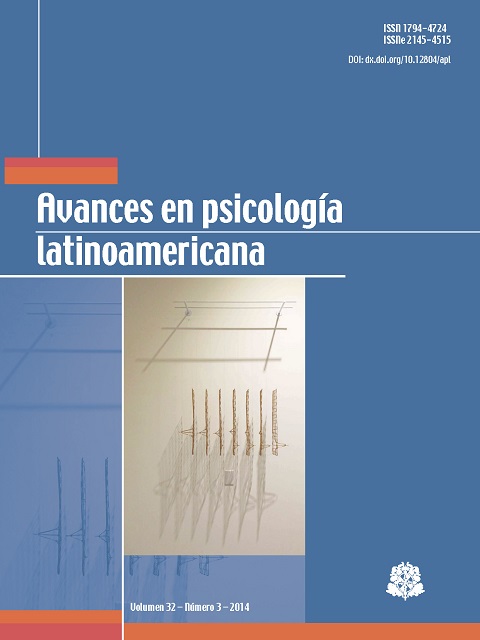Memoria autobiográfica de eventos estresantes, memoria traumática y trastorno de estrés postraumático: una revisión sistemática
Barra lateral del artículo
Contenido principal del artículo
Descargas
American Psychiatric Association, (2002). Manual Diagnóstico e Estatístico dos Transtornos Mentais. DSM IV-TR. Porto Alegre: Artes Médicas.
Bekinschtein, P., Cammarota, M., Igaz, L., Bevilaqua, L., & Izquierdo, I. (2007). Persistence of Long-Term Memory Storage Requires a Late Protein Synthesis- and BDNF Dependent Phase in the Hippocampus. Neuron, 53, 261-277. doi: 10.1016/j.neuron.2006.11.025
Berntsen, D., Willert, M., Rubin, D. C. (2003). Splintered Memories or Vivid and marks? Qualities and Organization of Traumatic Memories with and Without PTSD. Applied Cognitive Psychology, 17: 675–693. doi: 10.1002/acp.894
Berntsen, D. & Bohn, A. (2010). Remembering and forecasting: The relation between autobiographical memory and episodic future thinking. Memory & Cognition, 38, 265-278.doi:10.3758/MC.38.3.265
Berntsen, D., Rubin, D. C., (2006). The centrality of event scale: A measure of integrating a trauma into one’s identity and its relation to post-traumatic stress disorder symptoms. Behaviour Research and Therapy, 44, 219–231. doi:10.1016/j.brat.2005.01.009
Berntsen, D., Rubin, D. C., (2007). When a Trauma Becomes a Key to Identity: Enhanced Integration of Trauma Memories Predicts Posttraumatic Stress Disorder Symptoms. Appl. Cognit. Psychol, 21: 417–431.doi: 10.1002/acp.1290.
Berntsen, D., Rubin, D. C., (2008). The Reappearance Hypothesis Revisited: Recurrent Involuntary Memories after Traumatic Events and in Everyday Life. Mem Cognit, 36(2): 449–460. doi: 10.3758/MC.36.2.449
Berntsen, D.; Rubin D., C.; Siegler, I.C. (2011). Two versions of life: emotionally negative and positive life events have different roles in the organization of life story and identity. Emotion. 11(5):1190-201.doi: 10.1037/a0024940
Berntsen, D., Willert, M., Rubin, D. C. (2003). Splintered Memories or Vivid Landmarks? Qualities and Organization of Traumatic Memories with and Without PTSD. Appl. Cognit. Psychol. 17: 675–693. doi: 10.1002/acp.894
Blake DD, Weathers FW, Nagy LM, Kaloupek DG, Gusman FD, Charney DS, et al. The development of a clinician-administered PTSD scale. Journal of Traumatic Stress1995;8 (1):75e90.doi: 10.1007/BF02105408
Boals, A. (2010). Events That Have Become Central to Identity: Gender Differences in the Centrality of Events Scale for Positive and Negative Events. Appl. Cognit. Psychol. 24: 107–121.doi: 10.1002/acp.1548
Brewin, C.R., Dalgleish, T., Joseph, S. (1996). A dual representation theory of posttraumatic stress disorder. Psychol.Rev. 103:670–86.doi: 10.1037/0033-295X.103.4.670
Brewin, C. R. (2001).Memory processes in post-traumatic stress disorder. International Review of Psychiatry. 13, 159–163.doi: 10.1080/09540260120074019
Brewin, C. R. (2007). Autobiographical memory for trauma: Update on four controversies. Memory. 15 (3), 227-248.doi:10.1080/09658210701256423
Brewin, C. R. (2011). The Nature and Significance of Memory Disturbance in Posttraumatic Stress Disorder. Annu. Rev. Clin. Psychol. 7:203–27.doi: 10.1146/annurev-clinpsy-032210-104544
Brown, A. D., Root, J. C., Romano, T. A., Chang, L. J., Bryant, R. A., Hirst, W. (2012). Overgeneralized autobiographical memory and future thinking in combat veterans with posttraumatic stress disorder,. J. Behav. Ther. & Exp. Psychiat. 1-6.doi:10.1016/j.jbtep.2011.11.004
Bryant, A. R., Sutherland, K., Guthrie, R. M. (2007). Impaired Specific Autobiographical Memory as a Risk Factor for Posttraumatic Stress After Trauma. Journal of Abnormal Psychology, 116 (4), 837–841.doi: 10.1037/0021-843X.116.4.837
Charney, D. S. (2004). Psychobiological mechanisms of resilience and vulnerability: Implications for successful adaptation to extreme stress. American Journal of Psychiatry, 161, 195-216.doi: 10.1176/appi.ajp.161.2.195
Conway, M. A. & Pleydell-Pearce, C. W. (2000). The Construction of Autobiographical Memories in the Self-Memory System. Psychological Review, 107 (2), 261-288. doi:10.1037//0033-295X. 107.2.261
Dalgleish, T., Rolfe, J., Golden, A.M., Dunn, B. D., Barnard, P. J. (2008).Reduced Autobiographical Memory Specificity and Posttraumatic Stress: Exploring the Contributions of Impaired Executive Control and Affect Regulation. Journal of Abnormal Psychology, 117 (1), 236–241. doi: 10.1037/0021-843X.117.1.236
Engelhard, I. M., van den Hout, M. A., McNally, R. J. (2008). Memory consistency for traumatic events in Dutch soldiers deployed to Iraq. Memory. 16 (1), 3-9.doi:10.1080/09658210701334022
Ehlers, A., & Clark, D. M. (2000). A cognitive model of posttraumatic stress disorder. Behaviour Research and Therapy, 38 (4), 319-345.doi: 10.1016/S0005-7967(99)00123-0
Ehlers A, Hackmann A, Michael T. 2004. Intrusive re-experiencing in post-traumatic stress disorder: Phenomenology, theory, and therapy. Memory 12:403–15.doi: 10.1080/09658210444000025
Foa, E. B. (1995). Posttraumatic Stress Diagnostic Scale (PDS). Minneapolis: National Computer Systems.
Foa, E.B., Molnar, C., Cashman, L. (1995). Change in rape narratives during exposure to therapy for posttraumatic stress disorder. Journal of Traumatic Stress, 8, 675–690. doi: 10.1002/jts.2490080409
Graeff, F. G. (2003). Bases biológicas do transtorno de estresse pós-traumático. Revista Brasileira de Psiquiatria, 25(Supl. I), 21-24. doi:10.1590/S1516-44462003000500006
Harvey, A.G., Bryant, R.A., & Dang, S.T. (1998). Autobiographical memory in acute stress disorder. Journal of Consulting & Clinical Psychology, 66, 500-506doi: 10.1037//0022-006X.66.3.500
Hauer, B. J. A., Wessel, I., Engelhard, I. M., Peeters, L. L., Dalgleish, T., (2009). Prepartum autobiographical memory specificity predicts post-traumatic stress symptoms following complicated pregnancy. Memory, 17 (5), 544-556.doi:10.1080/09658210902953836
Horowitz, M. J., Wilner, N., & Alvarez, W. (1979). Impact of event scale: A measure of subjective stress. Psychosomatic Medicine, 41, 209–218.
Jacques, P. L. St., Botzung, A., Miles, A., Rubin, D. C. (2010). Functional neuroimaging of emotionally intense autobiographical memories in post-traumatic stress disorder. Journal of Psychiatric Research. 45 (5): 630-637. doi:10.1016/j.jpsychires.2010.10.011
Jacobs, W. J., Nadel, L. (1998). Neurobiology of reconstructed memory. Psychology, Public Policy, and Law, 4, 1110_1134.doi: 10.1037/1076-8971.4.4.1110
Kangas, M., Henry, J. L., Bryant, R. A. (2005).A Prospective Study of Autobiographical Memory and Posttraumatic Stress Disorder Following Cancer. Journal of Consulting and Clinical Psychology, 73 (2): 293–299.doi: 10.1037/0022-006X.73.2.293
Kazantzis, N., Flett, R. A.,Long, N. R., MacDonald, C.,Millar, M., Clark, C. (2009). Traumatic Events and Mental Health in the Community: a New Zealand Study. Int J Soc Psychiatry. 56: 35-50. doi: 10.1177/0020764008095929
Kleim, B., Ehlers, A. (2008). Reduced Autobiographical Memory Specificity Predicts Depression and Posttraumatic Stress Disorder After Recent Trauma. Journal of Consulting and Clinical Psychology. 76 (2): 231–242.doi:10.1017/S1352465807004080
Kleim, B., Wallott, F., Ehlers, A. (2008). Are Trauma Memories Disjointed from other Autobiographical Memories in Posttraumatic Stress Disorder? An experimental Investigation. Behavioural and Cognitive Psychotherapy, 36, 221–234.doi: 10.1017/S1352465807004080
Kopelman, M., Wilson, B.A., Baddeley, A.D., (1989). The autobiographical memory interview: a new assessment of autobiographical and personal semantic memory in amnesic patients. Journal of Clinical and Experimental Neuropsychology 11,727–744. doi: 10.1080/01688638908400928
LaGarde, G., Doyon, J., Brunet, A. (2010). Memory and executive dysfunctions associated with acute posttraumatic stress disorder. Psychiatry Research. 177, 144–149. doi:10.1016/j.psychres.2009.02.002
Lemogne, C., Bergouignan, L., Piolino, P., Jouvent, R., Allilaire, J., &Fossati, P. (2009). Cognitive avoidance of intrusive memories and autobiographical memory: Specificity, autonoetic consciousness, and self-perspective. Memory, 17, 1–7. doi:10.1080/09658210802438466
McNally, R. J. (1998, May). Information-processing abnormalities in anxiety disorders: Implications for cognitive neuroscience. Cognition and Emotion. Vol. 12 (3): 479-495. doi: 10.1080/026999398379682
McNally, R. J. (2003). Remembering trauma. Cambridge, MA: Belknap/Harvard. doi: 10.1038/nm1203-1448
Megías, J. L., Ryan, E.,Vaquero, J. M. M., Frese, B. (2007). Comparisons of Traumatic and Positive Memories in People with and without PTSD Profile. Appl. Cognit. Psychol. 21: 117–130.doi: 10.1002/acp.1282
Moradi, A. R., Herlihy, J., Yasseri, G., Shahraray, M., Turner, S., Dalgleish, T. (2008).Specificity of episodic and semantic aspects of autobiographical memory in relation to symptoms of posttraumatic stress disorder (PTSD). ActaPsychologica. 127, 645–653. doi:10.1016/j.actpsy.2007.11.001
Moradi, A. R., Abdi, A., Fathi-Ashtiani, A., Dalgleish, T., Jobson, L,.(2012). Overgeneral autobiographical memory recollection in Iranian combat veterans with posttraumatic stress disorder. Behaviour Research and Therapy. 50, 435-441. doi:10.1016/j.brat.2012.03.009
Nandrino, J.L., Pezard, L., Poste, A., Reveillere, C., & Beaune,D. (2002). Autobiographical memory in major depression: a comparison between first episode and recurrent patients. Psychopathology, 35, 335-340.doi: 10.1159/000068591
Pennebaker, J.W. (1997). Writing about emotional experiences as a therapeutic process. Psychological Science. 8:162–166.
Raes, F., Hermans, D., Decker, A., Eelen, P., Williams, J. M. G. (2003). Autobiographical Memory Specificity and Affect Regulation: An Experimental Approach. Emotion. 3 (2) 201–206.doi: 10.1037/1528-3542.3.2.201
Robinaugh, D. J., McNally, R. J. (2010). Autobiographical memory for shame or guilt provoking events: Association with psychological symptoms. Behaviour Research and Therapy. 48, 646-652.doi:10.1016/j.brat.2010.03.017
Rubin, D. C., & Kozin, M. (1984).Vivid memories. Cognition, 16, 81-95.doi: 10.1016/0010-0277(84)90037-4
Rubin, D. C., Feldman, M. E., Beckham, J. C. (2004). Reliving, Emotions, and Fragmentation in the Autobiographical Memories of Veterans Diagnosed with PTSD. Appl. Cognit. Psychol. 18: 17–35.doi: 10.1002/acp.950
Rubin, D. C., Schrauf, R. W., & Greenberg, D. L. (2003). Belief and recollection of autobiographical memories. Memory & Cognition, 31 (6), 887-901. doi: 10.3758/BF03196443
Rubin, D.C., Boals, A., Berntsen, D. (2008).Memory in Posttraumatic Stress Disorder: Properties of voluntary and involuntary, traumatic and non-traumatic autobiographical memories in people with and without PTSD symptoms. Journal ExpPsychol Gen., 137(4): 591–614.doi:10.1037/a0013165
Rubin, D. C., Boals, A., Klein,K. (2010). Autobiographical Memories for Very Negative Events: The Effects of Thinking about and Rating Memories. Cognit Ther Res., 1; 34(1): 35–48. doi:10.1007/s10608-008-9226-6.
Rubin, C. (2011). The coherence of memories for trauma: Evidence from posttraumatic stress disorder. Consciousness and Cognition 20, 857–865. doi:10.1016/j.concog.2010.03.018
Rubin, D. C., Dennis, M. F., & Beckham, J. C. (2011). Autobiographical memory for stressful events: The role of autobiographical memory in posttraumatic stress disorder. Consciousness and Cognition, 20 (3), 840-856. doi:10.1016/j.concog.2011.03.015
Schönfeld, S., & Ehlers, A. (2006). Overgeneral memory extends to pictorial retrieval cues and correlates with cognitive features in posttraumatic stress disorder. Emotion, 6, 611–621.doi: 10.1037/1528-3542.6.4
Schönfeld, S., Ehlers, A., Böllinghaus, I., Rief, W. (2007). Overgeneral memory and suppression of trauma memories in post-traumatic stress disorder. Memory, 15 (3), 339-352.doi:10.1080/09658210701256571
Scott, J., Stanton, B., Garland, A., & Ferrier, I.N. (2000).Cognitive vulnerability in patients with bipolar disorder. Psychological Medicine, 30, 467-472
Smeets, T., Giesbrecht, T., Raymaekers, L., Shaw, J., Merckelbach, H. (2010). Autobiographical Integration of Trauma Memories and Repressive Coping Predict Post-Traumatic Stress Symptoms in Undergraduate Student. Clin. Psychol. Psychother. 17, 211–218.doi: 10.1002/cpp.644
Sotgiu, I. Mormont, C. (2008). Similarities and Differences Between Traumatic and Emotional Memories: Review and Directions for Future Research. The Journal of Psychology, 142(5), 449–469.doi: 10.3200/JRLP.142.5.449-470
Spitizer, R. L., Williams J. R., Gibbon, M., First, M. B. (1992). The Structured Clinical Interview for DSM-III-R (SCID) In: History, rationale and description. Archives of General Psychiatry, 49 (8), 624-629.doi: 10.1001/archpsyc.1992.01820080032005
Sumner, J. A., Griffith J. W., Mineka, S. (2011). Examining the mechanisms of overgeneral autobiographical memory: Capture and rumination, and impaired executive control. Memory. 19 (2), 169-183.doi:10.1016/j.brat.2010.03.013
Sumner, J. A. (2012). The mechanisms underlying overgeneral autobiographical memory: An evaluative review of evidence for the CaR-FA-X model. Clinical Psychology Review, 32, 34–48.doi:10.1016/j.cpr.2011.10.003
Sutherland, K., Bryant, A. R. (2005). Self-defining memories in post-traumatic stress disorder. British Journal of Clinical Psychology. 44, 591–598.doi: 2009198973
Sutherland, K., Bryant, A. R. (2008a). Social problem solving and autobiographical memory in posttraumatic stress disorder. Behaviour Research and Therapy. 46, 154–161. doi:10.1016/j.brat.2007.10.005
Sutherland, K., Bryant, A. R. (2008b). Autobiographical memory and the self-memory system in posttraumatic stress disorder. Journal of Anxiety Disorders. 22, 555–560. doi:10.1016/j.janxdis.2007.03.008
Taylor, S.E. (1991). Asymmetrical effects of positive and negative events: The mobilization-minimization hypothesis. Psychological Bulletin, 111, 67-85.doi: 10.1037/0033-2909.110.1.67
van der Kolk BA, Fisler R. (1995). Dissociation and the fragmentary nature of traumatic memories: overview and exploratory study. J. Trauma. Stress 8:505–25. doi: 10.1002/jts.2490080402
Wessa, M., Jatzko A., Flor, H. (2006).Retrieval and emotional processing of traumatic memories in posttraumatic stress disorder: Peripheral and central correlates. Neuropsychologia. 44, 1683–1696. oi:10.1016/j.neuropsychologia.2006.03.024
Weathers, F. W., Litz, B. T., Huska, J. A., & Keane, T. M. (1994). The PTSD Checklist—Civilian Version (PCL-C). Boston, MA: National Center for PTSD.
Williams, J. M. G., Barnhofer, T., Crane, C., Hermans, D., Raes, F., Watkins, E. (2007). Autobiographical memory specificity and emotional disorder. Psychological Bulletin, 133, 122–148. doi: 10.1037/0033-2909.133.1.122
Williams, J. M. G., & Broadbent, K. (1986). Autobiographical memory in suicide attempters. Journal of Abnormal Psychology, 95, 144-149.doi: 10.1037/0021-843X.95.2.144
Yehuda, R. (2002). Current concepts: Post-traumatic stress disorder. New England Journal of Medicine, 346,108-114. doi: 10.1056/NEJMra012941
Detalles del artículo
Los autores conservan los derechos de autor y garantizan a la revista el derecho de ser la primera publicación del trabajo al igual que licenciado bajo una Creative Commons Attribution License que permite a otros compartir el trabajo con un reconocimiento de la autoría del trabajo y la publicación inicial en esta revista.
Artículos más leídos del mismo autor/a
- Daniele Lindern, Karine Aline Laini Silveira, Janaína Castro Núñez Carvalho, Christian Haag Kristensen, El uso de imágenes mentales en la Terapia Cognitivo-Conductual para el Trastorno de Estrés Postraumático: una revisión sistemática , Avances en Psicología Latinoamericana : Vol. 32 Núm. 3 (2014)








